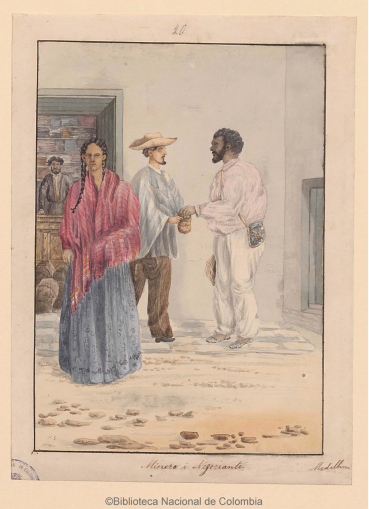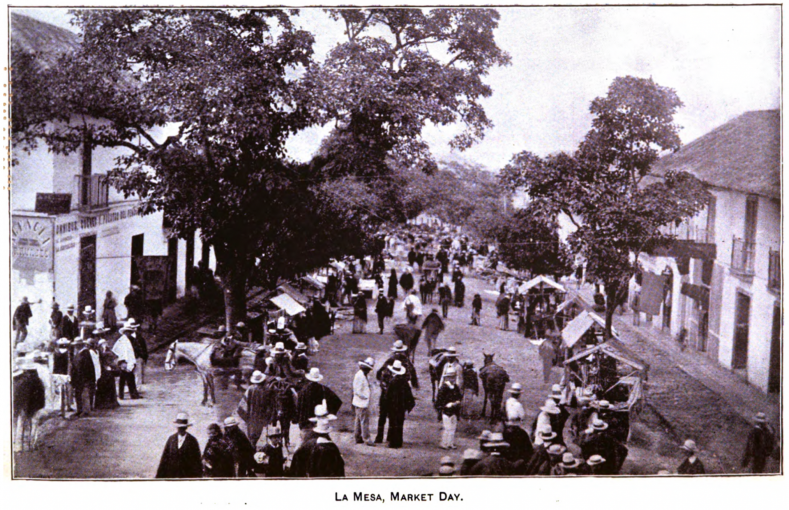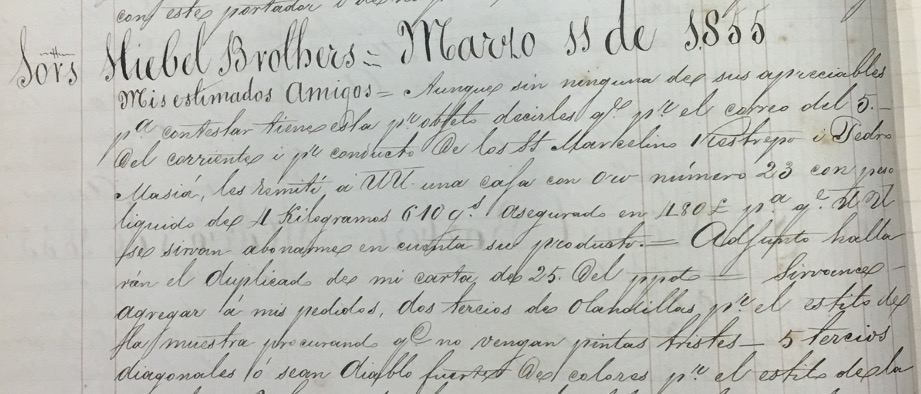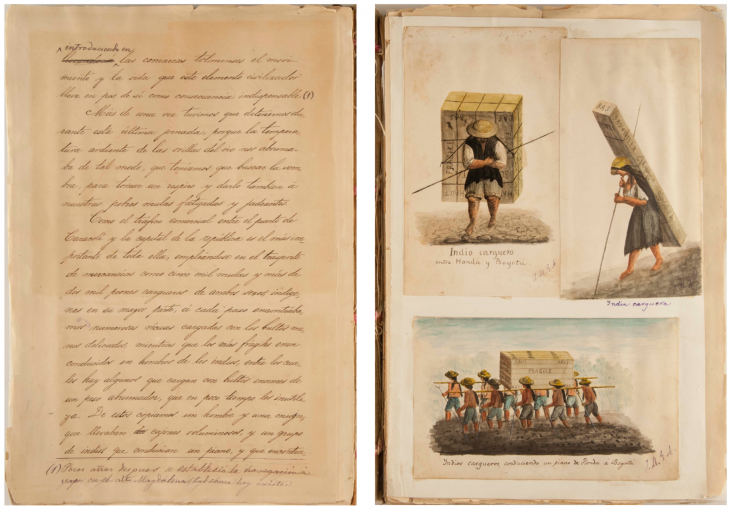Ana María Otero-Cleves and writing about the Global from the Periphery: Interview with the Winner of the Toynbee First Book Manuscript Workshop Competition (ENGLISH)

2022 Winner of the Toynbee First Book Manuscript Workshop competition: Ana María Otero-Cleves (Universidad de los Andes, Colombia)
Manuscript Commentators:
Toynbee Trustee Jeremy Adelman (Princeton University)
Jeremy Prestholdt (University of California, San Diego)
Frank Trentmann (Birkbeck, University of London)
Book manuscript:
Cherished Consumers: Global Connections, Local Consumption, and Foreign Commodities in Nineteenth-Century Colombia (provisional)
Manuscript summary:
Ana María Otero-Cleves’s book manuscript examines how Colombian peasants, artisans, formerly enslaved people, bogas (river boatmen), market women, and small landholders became the largest consumers of foreign commodities between the mid-nineteenth century and early twentieth century (1850–1910). It is the first study to argue that the consumption of foreign goods was not solely, nor primarily, an upper-class phenomenon and that the tastes and demands of the country’s popular sectors changed nineteenth-century patterns of production abroad. The manuscript demonstrates that far from being indigenous, the material culture of broad sections of the country’s population was inextricably intertwined with global trends by the end of the nineteenth century. It shows that the appropriation of imported commodities by Colombian popular sectors was in great part due to foreign manufacturers’ willingness to alter or redesign their products to satisfy their demands. Thus, by following the preferences of the popular sectors for English textiles, American machetes, and French patent medicines, among many other foreign commodities, the book demonstrates how, in their capacity as free citizens, Latin American consumers became active agents in the construction of the nation’s marketplace as well as dynamic participants in the global circulation of modern commodities.
By methodologically and narratively shifting from the periphery to the centre, the book offers an exciting and original perspective on global interconnectivity in the nineteenth century, where the taste of the popular sectors of apparently isolated countries, such as Colombia, played a key part. Historians, scholars, and students interested in the global history of consumption will find this seemingly marginal case study ideal for testing theories proposed by social scientists on global relationships and on the ability of “peripheral” subjects to transform global dynamics. By examining how popular consumers’ demands affected patterns of exchange and production in Europe and the United States, Otero-Cleves contests the presumption that Colombia’s global relationships in the nineteenth century were dictated solely by outsiders and, even more so, the country’s elites. Moreover, this case study forcefully challenges ongoing stereotypes about Latin America’s peripheral role in the world economy and its unquestionable “dependency” and, furthermore, the lack of agency in the marketplace of the popular classes.
By showing how popular consumption was a key broker between political economy and citizenship in the mid-nineteenth century, the manuscript also engages with the burgeoning historiography on subaltern groups and popular politics in nineteenth-century Latin America.
The manuscript shows how popular sectors participated in the market economy not only as part of the country’s labour force but as individuals engaged in the consumption and adoption of new needs and comforts; it also explores the extent to which their role as consumers shaped ideas and practices of citizenship in mid-nineteenth-century Colombia. The study not only suggests that citizenship was formed, contested, and recognised in fairs, streets, plazas, tiendas, and local markets but argues that men’s and women’s entry into the market economy and their pursuit of material betterment gave meaning to ideas of citizenship and fashioned practices of political recognition in the second half of the century.
Sources: Based on extensive research from multiple archives in Colombia (Bogotá, Medellín, and Cali), England (Oxford, London, Manchester, and Liverpool), and the United States (New York, Hartford, Washington, Wilmington, and Rochester), this manuscript employs a plethora of primary sources dating from the mid-nineteenth century to the 1910s, including foreign consular reports from British and North American agents and diplomats, commercial handbooks and manuals, travellers’ accounts and memoirs, and business records. As for Colombian sources, the study relies heavily on newspapers, contemporary accounts, commercial correspondence, literary pieces, official statistics, and governmental reports. Otero-Cleves is well aware that many of the peasants and labourers who form the core of the study did not leave any written trails of their own. This deficiency of primary material is supplemented by approaching other sources that, if analysed together, give at least some voice to those consumers who did not leave testimonies of their material experiences. Objects and visual sources, such as paintings and photographs, contributed greatly in this regard.
Interview

Nicole CuUnjieng Aboitiz: Congratulations on winning the inaugural Toynbee First Book Manuscript Workshop!
Ana María Otero-Cleves: Thanks, Nicole! And thanks for organising this interview. I must begin by saying that the workshop was an exceptional experience for someone who is about to publish. There are few, if not rare, opportunities for academics to discuss our work with people with extensive experience and expertise in the field. Before we publish an article in a journal or a chapter in a book, we generally receive written comments from reviewers. Still, there are few opportunities to clarify doubts, explore our arguments further, talk about the weaknesses we have identified in our research, or discuss its strengths. In that sense, the workshop was truly a prize! A unique opportunity, no doubt.
NCA: Having completed the workshop, what differences in arguments, narrative emphasis, contribution, or otherwise would you revise in the summary I just provided to your manuscript above?
AMOC: Among many, there are two things that the workshop helped me to define better. The first has to do with the way I framed the book. When I wrote the first draft, I knew my work contributed to studies on nineteenth-century Latin America, as well as to the global history of consumption. It still does and will. However, the workshop assured me that my book is, first and foremost, a case study to understand the global from the periphery. In the words of Jeremy Adelman, it is an opportunity to explore “what the periphery reveals about the globalisation of capitalism.” Our conversation helped me to visualise better what my work brings to global history from the point of view of Latin America, and it has given me a few ideas on how to show my contributions in the text decisively.
The second aspect that all three commentators challenged me to think strongly about was the place of “the political” in the text, particularly the connection between citizenship and consumption. The political character of consumption is something that historians have worked on extensively, and I contribute actively to that historiography. However, before the workshop, I was not sure if the way I was approaching this connection was the best way to do so. It is a critical discussion because it connects debates on republicanism, economic liberalism, citizenship, and the political economy in the second half of the nineteenth century—something that is not only relevant for Colombia but the entire hemisphere.
Professors Jeremy Adelman, Jeremy Prestholdt, and Frank Trentmann also identified fascinating issues my work engages in that are not highlighted in the text. For instance, how information about consumers’ preferences is communicated and translated to producers across the Atlantic. I had approached my work zeroing on the circulation of goods and people, but there is also an important and extremely interesting circulation of information. For example, how merchants from Quibdó—in the Colombian Pacific—let manufacturers from Manchester know about Colombians’ preferences in colours and designs. The commentators also noted how advertising in Colombia was closely related to the formation of print culture and the press in Latin America, a topic of great interest and worth addressing in the book.

NCA: Since the completion of your doctoral dissertation, on which this manuscript is based, you have introduced debates over citizenship into your argument to reconsider the sharp, putative divide between politics and economics—especially because, as you remind, this divide does not characterise the thought and practices of nineteenth-century subaltern groups. This is a fascinating insight, but you noted your uncertainty that citizenship was the right way to approach it or that the connections you draw between consumption and citizenship, via dignity and recognition, were working.
Relatedly, Jeremy Adelman commended you for moving the historiography away from the traditional work on state formation, such as his own, and for providing instead a wholly other take on the political. In this, you are not looking at mobilisation issues around consumption but at consumption as a mode of refashioning subjects as legible in certain ways. Could you explain the approach you had been taking regarding citizenship and how the workshop discussion may or may not have changed it since?
AMOC: Yes, the connection between consumption and citizenship is at the core of my argument. In my work, I claim that the popular sectors’ desire for foreign goods was intimately related to Colombians’ efforts to delineate and define citizenship. However, before the workshop, I was not entirely sure if the way I was connecting consumption and citizenship by way of struggles of political recognition was the way to go. Let me explain.
In my manuscript, I argue that “plebeian consumption” had different connotations and meanings for the upper and lower sectors of society. For the country’s elites, peasants’ pursuit of new need—in other words, their desire to consume English textiles or American machetes—became a vital piece of the mid-century republican and liberal project. Mid-1800s liberal politicians like Manuel Ancízar, Florentino González, and José María Samper, rather than considering the marketplace a site solely for economic exchange, saw commercial fairs, weekly markets, and local tiendas as central mechanisms for political integration. In other words, they saw the marketplace as a major mechanism for creating and shaping “civilised subjects” and good citizens. Mid-nineteenth-century lettermen also claimed that material desires encouraged labourers, peasants, and bogas (river boatmen) to work harder. Hence, in their eyes, consumption of new “necesidades” (necessities) would end up benefiting the material and moral progress of the nation by creating laborious and industrious citizens.
In the meantime, men and women from across the national territory embraced the marketplace as a public arena within which they could claim political recognition and consume goods as an alternative to demand such recognition. As recent historiography has shown, the mid-nineteenth-century political repertoire went far beyond voting. Certainly, constitutions mattered, as did the elite’s opinion over the scope and limits of citizenship. But Republican politics were also enacted by Colombians through other means and in different spaces, including the marketplace. Men and women joined these spaces and networks of exchange not only to participate in political debate—discussing politics in stores, fairs, seaports, and plazas—but to self-fashion and be validated by their peers as worthy citizens: wearing their best clothes and machetes on market day. As such, cotton textiles, linen shirts, machetes, and other foreign commodities became means through which popular consumers recognised themselves and sought recognition by others in the public sphere as vested individuals with rights and dignity.
As you said, consumption becomes an act of self-fashioning, and a means for peasants and labourers to become recognisable as political subjects by others. Let us think of it this way: it is not only that we strive to own certain things to “feel” part of the body politic and perceive ourselves as worthy human beings, but that we need those material goods to claim our dignity and our citizenship. The workshop made me aware of the importance of the concept of recognition to bridge together citizenship and consumption in mid-nineteenth-century Colombia. But most importantly, it left me with crucial questions to dwell on. For example, to what extent do elites’ views on political economy overshadow the moral economy of the peasantry? Did peasants buy into the rhetoric of the elite or were they strategic by embracing it? To what extent did they also resist the liberal model that welcomed consumption? After all, as Frank Trentmann rightly reminded us, the market can also alienate subjects. Critical questions to bear in mind.

NCA: Jeremy Prestholdt lauded your manuscript for its discussion of a wide spectrum of consumer practices and a broad range of everyday objects that people use, through which you contribute a nuanced view of consumption and global relationships that especially highlights the multidirectionality of those relationships. Could you articulate for us what this multi-directionality entails?
AMOC: Jeremy Prestholdt’s comment on the multi-directionality of the global relationships was an invitation to identify the concrete contributions of my work in relation to other works on nineteenth-century consumption from a global perspective, like his own. Each of the commodities I study—textiles, machetes, books, stationery, musical instruments—creates different dynamics between global actors. Some of these exchanges entail intense negotiations between producers, traders, and consumers over the physical characteristics of commodities, while others are driven by manufacturers’ somewhat independent decisions over quality and design.
To give you an example, one of my chapters deals with machetes, in particular the Collins machete, a brand preferred by Colombian peasants and produced in Hartford, Connecticut. According to the company’s president, Samuel W. Collins, their agents visited the factory monthly to confer with them and see if the shapes and sizes were suitable for South American customers. Company officials maintained a fluid correspondence with their agents in the region, who, in turn, transmitted their customers’ suggestions concerning product design. According to the Collins Company’s official history, it was standard for “natives” to try the machetes out and send wooden models or outlines traced on paper with the question: “Can you make one like this?” The Collins Company followed these models exactly, even if they looked bizarre to the manufacturers. The dynamics with textiles were different, however. Textile manufacturers in England, for instance, produced cotton piece goods on a grand scale to satisfy multiple markets. However, this did not mean that they did not take into consideration the consumers’ preferences in taste, colour, and design. They knew Colombian tastes, and they knew how to accommodate their preferences.
If you compare both cases, you can see that the relationships between producers, traders, and consumers were different. While some required collaboration, others were guided simply by occasional efforts at adaptation and negotiation between producers and consumers. Ultimately, this shows that we must recognise the multidirectionality of global relationships in the nineteenth century and the different degrees of participation of global actors in said relationships.

Indios cargueros conduciendo un piano de Honda a Bogotá, José María Gutiérrez de Alba (1822-1897). Excursión a Mariquita., del 27 de mayo al 4 de junio de 1874
NCA: Frank Trentmann commented that there would be in many readers’ minds the question as to whether this is the neoliberal project in an early instantiation. He encouraged you to prepare an answer to this and to conceptualise that answer further within your text. Could you give us a window into how you are thinking about this and how you previously thought about this?
AMOC: The short answer is yes; the story I tell is a key piece of the initial and complex consolidation of the economic liberal project. As I have mentioned, my work focuses on how Colombian peasants, artisans, formerly enslaved people, market women, and small landholders actively participated in the market economy. They demanded manufactures and traders to pay attention to their needs, preferences, and tastes. However—and I agree with Frank Trentmann—we should not forget that this story is also about the incorporation and subjection of the population to a global economy that emphasizes the value of free market competition. With this model comes inequality and poverty, two issues scholars have recently highlighted that had been blind spots in global history previously. I still do not have a concrete answer to Frank’s question. What I can say now is that the period I explore is a moment in time when individuals are being “captured” by the economic system while they maintain a capacity to resist it, transform it, and adapt it (although in a limited form). Exploring the tension between these two processes is one of the most exciting challenges of doing global history from the bottom up.
NCA: Has the manuscript workshop given you any insight on the formal or aesthetic components to writing a book? Did you gain any insight in terms of prose, structure, narrative arc, etc. that you could share with us?
AMOC: Yes, and all suggestions and recommendations were very helpful. Besides our discussion on substantive issues, which included advice on providing further consistency and strength to my arguments and highlighting my original contributions, all three commentators gave me great insights into what to consider when publishing your first book. These included recommendations on how to broaden my audiences, how to make the most of my illustrations, and how to choose a publisher, among many others—all critical for someone who is about to publish her first book. As I said before, we rarely discuss these topics in depth at this stage of career. This workshop gave me the unique opportunity to talk about these issues with scholars with comprehensive and incredible academic backgrounds.
Thanks again for this wonderful opportunity!